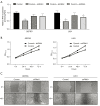Bromodomain containing 4 transcriptionally activated Deltex E3 ubiquitin ligase 2 contributes to glioma progression and predicts an unfavorable prognosis
- PMID: 35434025
- PMCID: PMC9011215
- DOI: 10.21037/atm-22-555
Bromodomain containing 4 transcriptionally activated Deltex E3 ubiquitin ligase 2 contributes to glioma progression and predicts an unfavorable prognosis
Abstract
Background: Glioblastoma multiforme (GBM) is the most common type of glioma, and the most aggressive brain malignancy in adults. This study sought to identify novel survival-status related markers, and examine their function in glioma.
Methods: The gene expression, survival heatmaps, and Kaplan-Meier survival plots of the genes were analyzed by using gene expression profiling interactive analysis (GEPIA) dataset, Linked Omics. The single-cell data analysis and tumor immune infiltration analysis was conducted by Tumor Immune Estimation Resource (TIMER) dataset. DBTRG and U251 cells with silenced Deltex E3 ubiquitin ligase 2 (DTX2) expression were constructed and used for Cell Counting Kit 8 (CCK-8), and wound healing assay in vitro. Chromatin immunoprecipitation sequencing (ChIP-seq) analysis was used to explore the histone activation marks and transcription factors DTX2 promoter. Dual-luciferase assays were carried out to detect the luciferase activities of bromodomain containing 4 (BRD4) binding to DTX2.
Results: We first conducted a survival-status analysis to identify survival status-related genes in The Cancer Genome Atlas GBM and low-grade glioma data sets. A subsequent analysis identified 3 novel prognostic biomarkers; that is, DTX2, cytochrome P450 oxidoreductase, and Williams-Beuren syndrome chromosomal region 16 protein. In the validation Chinese Glioma Genome Atlas data sets, DTX2 showed the best performance, and was examined in a further analysis. Next, 3 short-hairpin ribonucleic acids were designed to silence DTX2 expression, and CCK-8 and wound-healing assays were applied to study the function of DTX2. We found that DTX2-silenced glioma cells exhibited a significant decrease in their growth and migration capabilities. Finally, the molecular basis for increased DTX2 in glioma was investigated via ChIP-Seq analysis and luciferase assays. The analysis revealed that DTX2 was transcriptionally activated by BRD4.
Conclusions: In conclusion, BRD4 transcriptionally activates DTX2, contributes to glioma progression, predicts an unfavorable prognosis, and could provide new options for glioma prognosis prediction and treatment.
Keywords: Deltex E3 ubiquitin ligase 2 (DTX2); Glioma; bromodomain containing 4 (BRD4); survival status.
2022 Annals of Translational Medicine. All rights reserved.
Conflict of interest statement
Conflicts of Interest:All authors have completed the ICMJE uniform disclosure form (available at https://atm.amegroups.com/article/view/10.21037/atm-22-555/coif). The authors have no conflicts of interest to declare.
Figures





Similar articles
-
DTX2 promotes glioma development via regulation of HLTF.Biol Direct. 2024 Jan 2;19(1):2. doi: 10.1186/s13062-023-00447-w. Biol Direct. 2024. PMID: 38163902 Free PMC article.
-
Bromodomain-containing protein 4 activates cardiotrophin-like cytokine factor 1, an unfavorable prognostic biomarker, and promotes glioblastoma in vitro.Ann Transl Med. 2022 Apr;10(8):475. doi: 10.21037/atm-22-1164. Ann Transl Med. 2022. PMID: 35571403 Free PMC article.
-
Hypomethylation-induced prognostic marker zinc finger DHHC-type palmitoyltransferase 12 contributes to glioblastoma progression.Ann Transl Med. 2022 Mar;10(6):334. doi: 10.21037/atm-22-520. Ann Transl Med. 2022. PMID: 35434031 Free PMC article.
-
Targeting Deltex E3 Ubiquitin Ligase 2 Inhibits Tumor-associated Neutrophils and Sensitizes Hepatocellular Carcinoma Cells to Immunotherapy.Adv Sci (Weinh). 2025 Feb;12(7):e2408233. doi: 10.1002/advs.202408233. Epub 2024 Dec 29. Adv Sci (Weinh). 2025. PMID: 39733452 Free PMC article.
-
Functions and Molecular Mechanisms of Deltex Family Ubiquitin E3 Ligases in Development and Disease.Front Cell Dev Biol. 2021 Aug 25;9:706997. doi: 10.3389/fcell.2021.706997. eCollection 2021. Front Cell Dev Biol. 2021. PMID: 34513839 Free PMC article. Review.
Cited by
-
DTX2 promotes glioma development via regulation of HLTF.Biol Direct. 2024 Jan 2;19(1):2. doi: 10.1186/s13062-023-00447-w. Biol Direct. 2024. PMID: 38163902 Free PMC article.
-
[DTX2 overexpression promotes migration and invasion of colorectal cancer cells through the Notch2/Akt axis].Nan Fang Yi Ke Da Xue Xue Bao. 2023 Mar 20;43(3):340-348. doi: 10.12122/j.issn.1673-4254.2023.03.02. Nan Fang Yi Ke Da Xue Xue Bao. 2023. PMID: 37087577 Free PMC article. Chinese.
-
[High expression of DTX2 promotes proliferation, invasion and epithelial-mesenchymal transition of oxaliplatin-resistant colorectal cancer cells].Nan Fang Yi Ke Da Xue Xue Bao. 2025 Apr 20;45(4):829-836. doi: 10.12122/j.issn.1673-4254.2025.04.18. Nan Fang Yi Ke Da Xue Xue Bao. 2025. PMID: 40294933 Free PMC article. Chinese.
-
The DTX Protein Family: An Emerging Set of E3 Ubiquitin Ligases in Cancer.Cells. 2023 Jun 21;12(13):1680. doi: 10.3390/cells12131680. Cells. 2023. PMID: 37443713 Free PMC article. Review.
-
Deltex E3 ubiquitin ligase 4 promotes thyroid cancer progression through stearoyl-CoA desaturase 1.Funct Integr Genomics. 2023 Aug 23;23(3):280. doi: 10.1007/s10142-023-01215-9. Funct Integr Genomics. 2023. PMID: 37612343
References
LinkOut - more resources
Full Text Sources
